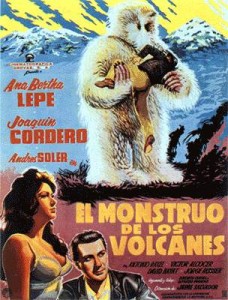Saturday, November 6, 2010
The volcano Gatekeeper
One of the sad - but not unexpected - stories to come from the eruption at Mount Merapi concerns the death of the "Gatekeeper" of the volcano, Mbah Marijan. Marijan was mentioned in a 2008 National Geographic article, "The Gods Must Be Restless", that I blogged about a long time ago - and that has turned out to be depressingly prophetic...
Want to read the rest of this post? Go to Magma Cum Laude's new home at the AGU Blogosphere - and remember to update your links and RSS feeds! This will be the last article crossposted to this site; after today, you will need to go to the new AGU page to follow the blog.
Wednesday, November 3, 2010
Support volcano monitoring and future volcanologists
 Santiaguito Volcano Observatory Fundraiser
Santiaguito Volcano Observatory FundraiserIt's been a while since I wrote about this, and it's definitely time for an update. If you're new to Magma Cum Laude, or just haven't visited the site for a while, you'll notice that there's a "Donate to Santiaguito" tab on the top of the page. Clicking there will help you learn a bit more about a fundraising effort I helped start earlier this year for the Santiaguito Volcano Observatory in Guatemala. For my field research, I spent most of my time either at the Observatory or working with its staff, and realized that although they're in a prime location to collect valuable data about an active volcano, they have very little of the resources and equipment they need...
Want to read more about Earth science fundraising? Check out the rest of this post at Magma Cum Laude's new home on the AGU Blogosphere. Don't forget to update your bookmarks and RSS feeds!
Sunday, October 31, 2010
Saturday, October 30, 2010
Geological Frightfest: The Monolith Monsters

Lee Allison at Arizona Geology deserves credit for inspiring the last movie in the Frightfest series - in his post from June about the Piranha 3D movie, he also mentioned The Monolith Monsters. Again, it's another 1950s movie I haven't had the chance to see, but I'll definitely have to remedy that if I can...guess what's next on the Netflix queue? With a title like that, though, I couldn't resist looking it up. And boy, this one is a doozy. Here's the IMDB summary:
A strange black meteor crashes near the town of San Angelo and litters the countryside with fragments. When a storm exposes these fragments to water, they grow into skyscraper-sized monoliths which then topple and shatter into thousands of pieces that grow into monoliths themselves and repeat the process. Any humans in the way are crushed or turned into human statues. The citizens of San Angelo desperately try to save themselves and the world from the spreading doom.Wikipedia also expands on this with some dirt on some of the main characters, who happen to be geologists (though apparently not very good at on-the-fly rock identification):
In the desert region of San Angelo, California, geologist Ben Gilbert brings a strange black rock back to his office, where he and bored local reporter Martin Cochrane examine it but fail to determine its origin. That night, a strong wind blows a bottle of water over onto the rock, which begins to bubble and smolder. The next day, the head of the geological office, Dave Miller, returns to town from a business trip and finds the office destroyed by a huge growth of black rock and Ben dead, in a rock-hard, apparently petrified state.Things certainly go downhill from there. The rocks spread via the pockets of students on a geology field trip, and pretty soon folks are turning into stone left and right. Not only are the rocks sucking silica out of people, but coming into contact with water allows them to grow and multiply. (Since humans only contain trace amounts of silica, these are obviously not very smart rocks.) The geologists eventually figure out that these are evil outer space rocks, and that salt water (???) will stop their growth. I won't tell you the thrilling conclusion, although it's there in the Wikipedia summary (spoiler alert!) if you want to read it.
This movie is impressive not only for the fact that it has evil space rocks sucking the silica out of people, but for its fantastically corny (and geologically incorrect) dialog. Here are a few gems:
"The desert's full of things that don't belong. Take the salt here. Used to be an ocean bed. Now that ocean knew that the middle of a desert was a pretty silly place for it to be, so it just dried up and went away."Okay, the last one wasn't wrong, but I just had a mental image of a lurking meteor(ite), and it looked something like this:
"You've got to remember, Dave, when this hit our atmosphere, it burned at such a fantastic temperature, that its metal-bearing compounds could have been altered - left ready to activate, to grow!"
"From infinity they come. Meteors! Another strange calling card from the limitless regions of space - its substance unknown, its secrets unexplored. The meteor lies dormant in the night - waiting!"
Watch out, folks. Those space rocks will get you.
Friday, October 29, 2010
Geological Frightfest: El Monstruo de los Volcanes
 Tonight's post will be a short one, because it's Friday and I just spent the last hour carving a pumpkin. This Frightfest offering comes via the suggestion of a devoted reader (thanks, Mom!), and I had to post it, even though I can't find out a lot about the movie. This is the best I could dig up for El Monstruo de los Volcanes: A yeti-like creature with the power to hypnotize its victims stalks the slopes of Mount Popocatepetl, attacking construction workers who are building an inclined railway on the volcano.
Tonight's post will be a short one, because it's Friday and I just spent the last hour carving a pumpkin. This Frightfest offering comes via the suggestion of a devoted reader (thanks, Mom!), and I had to post it, even though I can't find out a lot about the movie. This is the best I could dig up for El Monstruo de los Volcanes: A yeti-like creature with the power to hypnotize its victims stalks the slopes of Mount Popocatepetl, attacking construction workers who are building an inclined railway on the volcano.Yep, a 1962 horror movie about a volcano yeti. I don't think I can add much to that. (Here's a Spanish website with a short blurb about the movie, for those of you who can read it. Oh, and funicular is another word for an inclined railway, if you get stuck translating it.)
On the volcanic side of things, Volcan Popocatepetl (the name means "smoking mountain" in the Aztec language) is a large stratovolcano about 70 km SE of Mexico City. Its most recent eruption began in January 2005 with a series of phreatic explosions, and has continued since with explosive eruptions of ash and the extrusion of a lava dome. (Check out the GVP's monthly and weekly summaries for more details!)
Thursday, October 28, 2010
Geological Frightfest: Fantasia
 |
| http://en.wikipedia.org/wiki/File:Fantasia-poster-1940.jpg |
I loved Fantasia as a child, and still do - but I have to admit that this sequence was pretty darn scary. (Disney did include it years later in their Halloween Treat TV special, after all - remember that? I used to watch it every year.) Anyway, a quick summary of the animation: In the dead of night, the huge, craggy mountain looming over a small European town becomes the haunt of a huge winged demon and the gathering place of ghosts, ghouls, devils, witches, and all manner of fell creatures. They proceed to have a fiery revel, but are forced back to their lairs by the tolling of church bells.
While the animation is truly imaginative, it's the music that brings me to a geological reference - and the setting that inspired Mussorgsky's title. (Or, rather, Rimsky Korsakov's orchestral arrangement of Mussorgsky's original tone poem St. John's Night on the Bare Mountain.) A bald or bare mountain, in East Slavic (and especially Ukranian) mythology, is a place where witches and other evil creatures gather for their Sabbath. In Ukranian, the term is lysa hora, which is also the name given to many "bald" mountains in Ukraine and Poland. One of the most famous is the Lysa Hora in Kiev, which was supposedly the site of some of the largest witches' gatherings.
This got me to wondering: Why would these hills be bare in the first place? Perhaps there's some geology at work here. In the Blue Ridge mountains, for example, there are a number of spots where the mountaintops are rocky and relatively bare of trees; Old Rag Mountain is topped with granite, and Blackrock Summit with well-cemented quartz sandstone. I was able to find this map of the geology of the USSR (from 1944), but I can't read or type Cyrillic, so it's not much help. Ole Nielsen has a post on kimberlites in the Ukranian Shield which mentions granites, an excellent candidate rock type for bare-topped hills, and possibly what one might find on the summit of a lysa hora. Why would these rocks form bare summits? Well, granite can take an extremely long time to form enough soil to support plant life, especially if it's exposed to transport processes by being at the top of a mountain - and while a sandstone might weather more easily, it needs some organic inputs before it will form anything but...well, sand.
So, it's a good bet that the impressive winged demon in the Fantasia sequence is clinging to something granitic, although the craggy peak in the film is showing just a teensy bit of vertical exaggeration, if you ask me.
The move has finally happened!
Subscribe to:
Posts (Atom)










